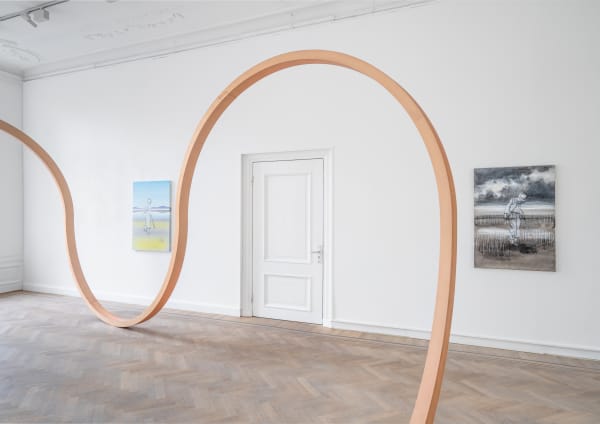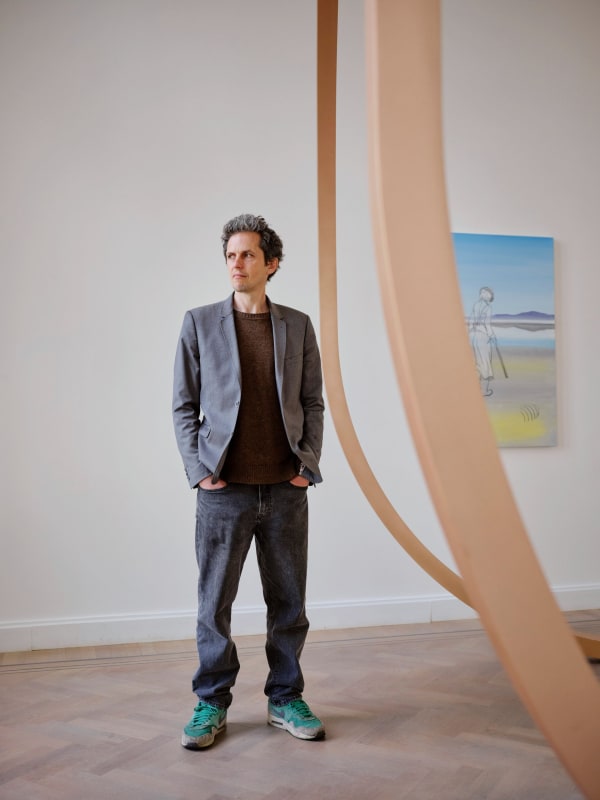Charles Avery: The Hunter returns / goes away from
GRIMM is pleased to present The Hunter returns / goes away from, an exhibition of new works by Charles Avery at its Amsterdam gallery opening on May 12, 2022 during the Amsterdam Art Week.
Charles Avery’s latest exhibition sees him foreground the logical and mathematical principles undergirding the nameless fictional Island that has been the focus of his work for almost two decades. In place of the artist’s customary presentations of drawings and objects teeming with pictorial and narrative detail, this show has an atmosphere of brooding minimalism, describing a landscape – and a mental space – in which motifs and concepts are isolated, the better to be (re-)examined.
In four new paintings, we see the androgynous Hunter – a key figure in Avery’s epic Islanders project since its inception – wander through bleak, tundra-like terrain, shoulders hunched, head bowed, at the mercy of the fluctuating weather systems that bear down upon him. Far from home, and with his gun pointed impotently at the ground, we might think of him as an archetype of hopeful, hopeless pursuit, and as an emblem of our own clumsy chasings after love and truth.
The specific quarry that has brought the Hunter to this wilderness is the fabled Noumenon – a beast whose existence is, at best, doubtful – which he plans to deliver up as a trophy to his beloved, the skeptical Miss Miss, thus providing irrefutable proof of his worthiness and devotion. And yet, his only reward for his efforts is to have become helplessly lost. As he trudges through this inhospitable landscape – a place the artist has described as somewhere ‘the idea of time breaks down, likewise meaning’ – awaiting an outcome that may never arrive, he begins to reflect not only on the wisdom of his quest, and on the affections of Miss Miss, but also on the nature, even the reality, of the home he left behind.
Looking across the four paintings (all of which are of equal size, and hung at the same height) we note how the Hunter’s own body appears less a solid object inhabiting the landscape than a ghostly outline superimposed on it, while his coding as a masculine paradigm is complicated by his delicate frame, and the bun of fair hair that peeks from beneath his hat. Perhaps the only unequivocal aspect of these works is their common horizon, which functions as an equator of sorts in the context of the exhibition space.
If Avery’s paintings are concerned with the subjective realm of fiction, then his sculptures inhabit more objective terrain. Occupying the volume of the gallery, Untitled (Square Circle) (2021) is a large bronze form that loops above and below the paintings’ horizon line like a three-dimensional sinewave (a mathematical curve defined in terms of the sine trigonometric function, which occurs in nature in light- and sound-waves), and when viewed in plan describes a perfect rectangle of the proportions 2:1.
Referred to by Avery as an ‘Henge’, a term that suggests a prehistoric monument whose meaning has been lost in the mists of time, this work alludes, as its title suggests, to a question first formulated by the Pre-Socratic philosopher Anaxagoras: how might one create a square equal in area to a given circle? This is a problem that admits no geometric solution, hence ‘squaring the circle’ has become (via literary works including Dante’s Paradiso and James Joyce’s Ulysses) a common metaphor for impossible enterprises – something with which the Hunter is, of course, familiar, whether he knows it or not.
In pairing the Untitled (Square Circle) with his four paintings, Avery suggests that the Hunter has stumbled across this ‘Henge’ in his wanderings through the wilderness. Might it be a sign of life in this seemingly desolate landscape? Some arcane clock or compass, which would allow him to navigate his way home, if only he could work out how to read it? Perhaps, yet the object’s pure form appears to stubbornly resist hermeneutic analysis, while its repeating curves threaten to lock the Hunter into a disorienting loop – spatial, temporal, conceptual – from which there’s no hope of escape. Like light- or sound-waves, the waves of Untitled (Square Circle) surely transmit something, but what this is remains elusive. The ‘Henge’ might be an object of great significance, or merely a charismatic form devoid of meaning. We might wonder to what degree the Hunter is aware of the irony of his situation: to set out to capture the Noumenon, and instead find himself caught in this strange, unyielding trap.
Avery’s purposefully lopsided exhibition title, The Hunter returns / goes away from operates as an index of the Hunter’s ambiguous situation. While the word ‘returns’ implies an intention and a planned destination, maybe even a triumphant homecoming – a Hollywood ending – the term ‘goes away from’ does not. Rather, all it communicates is the fact of the Hunter’s being, and his indeterminate roaming through a space where the rules of time and meaning do not obtain.
– Tom Morton, London 2022














